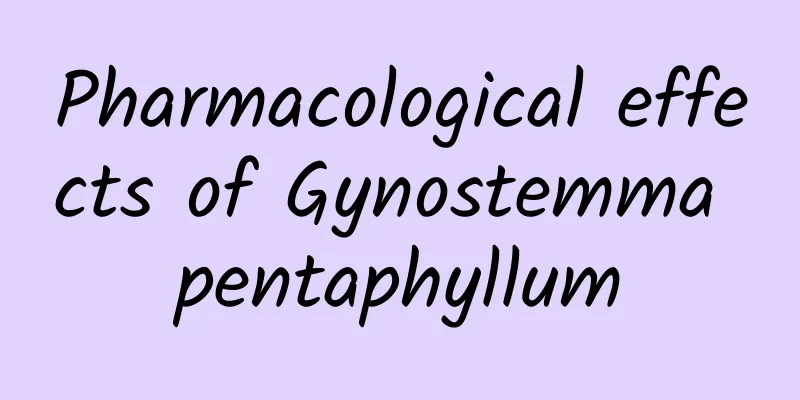Pharmacological effects of Gynostemma pentaphyllum

|
Having a healthy body can enable us to enjoy life better. Among them, Gynostemma pentaphyllum is the most common Chinese medicinal material. It can often improve the appetite in daily life and it is a very good Chinese medicinal material. It can play different conditioning roles on the body. However, if you want to improve your body better, you must master the efficacy of the medicine. Let's learn about the pharmacological effects of Gynostemma pentaphyllum Chinese herbal medicine. Pharmacological effects of Gynostemma pentaphyllum 1. Rats with hyperlipidemia induced by high-sugar and high-fat diet had significantly increased serum neutral fat and blood LPO. If they took GPs 500mg/kg and 100mg/kg (mixed in feed) for 7 weeks, serum neutral fat and total cholesterol levels decreased significantly, and the increase of LPO in the liver was inhibited. Experimental hyperlipidemia rabbits were gavaged with 100 mg/kg of GPs for 4 weeks, which could significantly counteract the increase of serum total cholesterol (TC), but seemed to have little effect on triglycerides (TG) and high-density lipoprotein cholesterol (HDLc). HDL is known as an anti-atherosclerosis (As) factor. Since HDLc increases with the increase of TC levels, it is not meaningful to compare its absolute value. It is currently advocated to use AsI (atherosclerosis index) = [(TC-HDLc)/HDLc] or HDLc/TC to measure the susceptibility of an individual to As. Calculations show that GPs can significantly reduce AsI and increase HDLc/TC, which is undoubtedly of positive significance in preventing As. Cholesterol in As plaques is mainly in the form of low-density lipoprotein (LDL) macromolecules that are deposited on the arterial wall, inducing proliferation of smooth muscle cells in the wall and damaging vascular endothelial cells. Calculations show that GPs can significantly reduce LDL levels and have a good effect on preventing As. 2. The serum LPO and myocardial lipofuscin (Lf) levels of hyperlipidemic rabbits were significantly higher than those of normal rabbits. GPs could significantly reduce serum LPO and myocardial Lf, indicating that GPs also has the function of resisting oxygen free radicals and protecting the vascular endothelium. When hyperlipidemic rats were gavaged with 100mg/kg and 300mg/kg GPs for 15 days, the blood TC, TG and LDL levels were reduced and the HDL/LDC ratio was significantly increased. Giving mice 300 mg/kg of GPs in drinking water for 4 months can inhibit or (and) eliminate the formation of myocardial Lf. In mice with hyperlipidemia caused by intraperitoneal injection of fresh egg yolk emulsion, oral administration of GPs 200 mg/kg for 7 days can significantly reduce blood TC concentration; in rats with hyperlipidemia caused by high-fat diet, oral administration of GPs 200 mg/kg for 7 days can significantly reduce TC, LDL and very low density lipoprotein (VLDL) levels, and increase HDL and HDL/LDL ratio. 3. Patients with hyperlipidemia can also lower blood TC, TG, and LDLc by taking GPs. It is also reported that patients with hyperlipidemia taking GPs 40mg, 3 times a day, for a total of 30 days, can significantly reduce the content of serum apolipoprotein (apoB100) and lipoprotein (LP (a), which is considered to be of great significance for improving blood supply to systemic tissues and preventing atherosclerosis, but has no significant effect on the content of serum HDLc, LDLc, VLDLc and TC, TG. Mice freely drinking Gynostemma pentaphyllum alcohol extract for 13 days can not only improve the activity of liver SOD, but also enhance the heat and acid resistance of SOD, playing a protective role of SOD. In vitro, GPs has a significant inhibitory effect on the generation of LPO in liver homogenate of elderly rats. Rats were gavaged with GPs 0.25g/kg for 8 days, placed in an ozone cabinet (free radical model of ozone damage) and continued to be administered for 10 days, which can significantly reduce the content of liver and plasma LPO below the control, and the activity of erythrocyte SOD is also significantly higher than that of the control group. Elderly rats (26 months old) took GPs 0.05g/kg for 80 days in drinking water, which can also significantly reduce the content of liver LPO and enhance the activity of erythrocyte SOD. The above is an introduction to the pharmacological effects of the Chinese herbal medicine Gynostemma pentaphyllum. After understanding it, we know that Gynostemma pentaphyllum has a good effect on the treatment of hyperlipidemia and hypertension, but we must use boiling water when soaking it in water, so that its efficacy can be better demonstrated. |
<<: Is Gynostemma Pentaphyllum Total Glycoside Capsule a Chinese patent medicine?
>>: Can Jiaogulan and Lingzhi be soaked in water and drunk at the same time?
Recommend
The efficacy and function of snow pork
Since Chinese medicine has fewer side effects, mo...
The efficacy and function of Ophiopogon japonicus
Speaking of Bombyx mori, we are all familiar with...
The efficacy and function of Coprinus comatus
Diseases require improvement through medicine. Di...
Microalgae: Eats carbon dioxide and spits out bio-oil
Science and Technology Daily reporter Yong Li and...
The efficacy and function of Zishi
Zizishi is a traditional Chinese medicine. In add...
Let me tell you a ghost story: The electric saw was invented to facilitate sawing the pelvis to give birth
Although humans have been using saws for thousand...
The efficacy and function of hyssop
Ligusticum chuanxiong is a relatively familiar tr...
Cats and dogs seem very smart, so why don’t they have consciousness?
In the posts about consciousness that I have publ...
When is the best time to eat wolfberry?
Wolfberry is sweet, mild in nature and non-toxic....
How is bird's nest formed?
Speaking of bird's nest, everyone must be fam...
Smith Micro: Business travelers interested in hotel mobile services
Mobile devices, due to their flexibility and conv...
The efficacy and function of rose root
Chinese medicinal materials are very effective in...
Ahhh, it's winter already, why are there still so many mosquitoes recently? !
Recently, I wonder if friends in other parts of t...
These scientists' magical experiments are dedicated to studying how to "rejuvenate"
Staying young is basically one of the common purs...
Did you order this tripe or that tripe?
1 Grass tripe, golden tripe, and hair tripe (beef...
![[Smart Farmers] Pay attention to this living "little stick"! How powerful is the "master of disguise" in the biological world?](/upload/images/67f0a316c4bab.webp)








